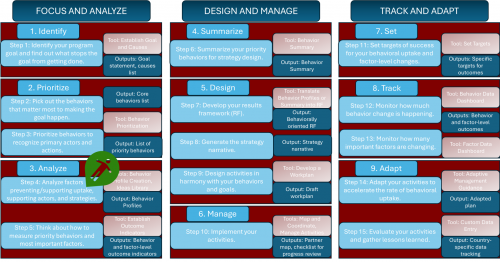Behavior analysis is at the heart of Think | BIG. This analysis helps you understand the context and your primary actors. The purpose is to find evidence-backed routes to make wise program choices. That accelerates the change you want to see in the communities you care about.
The core tool in the analysis of your priority behaviors is the Behavior Profile. Pulling together data and field research into a Behavior Profile or Profiles (you can put together as many as you need for a project) strengthens your ability to make your strategy and program behavior-oriented. And behaviors get results.
Create a Behavior Profile (online or offline), then learn how our visual approach to Behavior Profiles lets you trace concrete pathways to change.
As you go through the process, check out the sample Behavior Profiles developed by other social and behavior change (SBC) programmers. They might help you.
Gather research you have collected during the formative research stage and have it ready to use.
Now, identify what steps your primary actors need to take to practice the priority behavior. The steps are small actions that the primary actor needs to do to practice the behavior. If the primary actor follows these steps, they have practiced the behavior. The tool will guide you on how to fill in the steps.
Next, pulling from your guiding evidence, decide which factors influence your primary actors in practicing the priority behaviors. Factors describe why a person does or does not practice a behavior or carries out a step needed to practice the behavior. A factor can be a barrier or a motivator.
Once you decide which factors to include, examine these factors some more and select only the most critical. Our handy guide will help you make these choices. We know it can be difficult to eliminate things! But you only want the most essential to be captured in your Behavior Profiles, so you see your desired impact.
Now, determine who can help you carry out activities and identify supporting actor actions or what they can do to support the work. Many times, the primary actor alone can’t practice the behavior without the support of others at the institutional, community, and household levels.
When you have fully completed your analysis, based on your guiding evidence, develop a list of strategies that address your set of critical factors. Make sure you link every strategy to your critical factors. It’s possible that one strategy may address several critical factors. But all strategies must follow the pathways and must address at least one of the critical factors. As you determine your strategies, also be sure they incorporate the supporting actors and their actions, as appropriate. There should be no supporting actor action that is not (1) connected to a critical factor and (2) used in a strategy.
If you want some fresh thinking about your factors and strategies, visit the Ideas Library to jumpstart your brain. (If you get a spark of inspiration, don’t say we didn’t warn you.)
Need more help with your Behavior Profiles? Not a problem:




 The Manoff Group was acquired by JSI in 2022.
The Manoff Group was acquired by JSI in 2022.